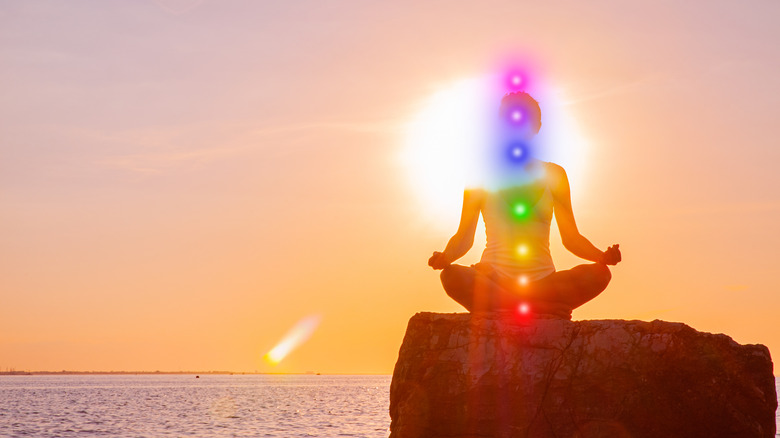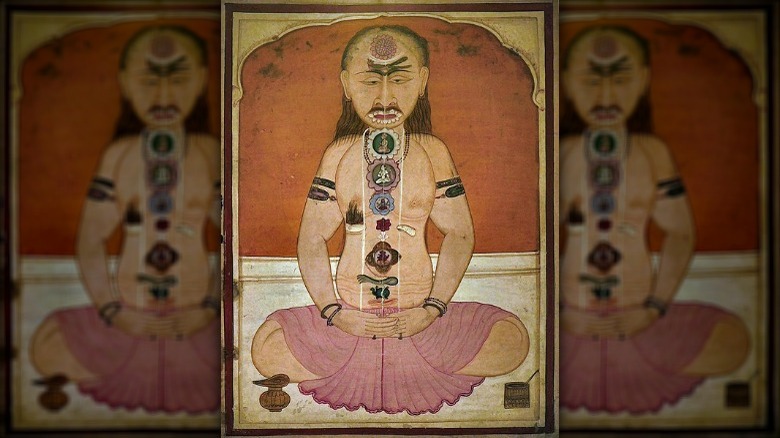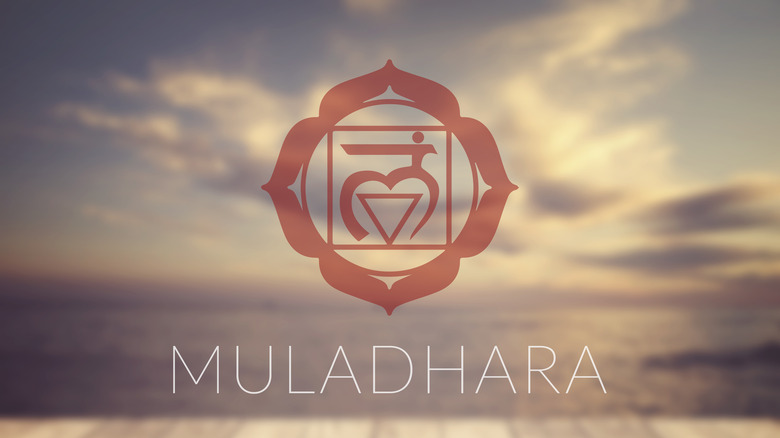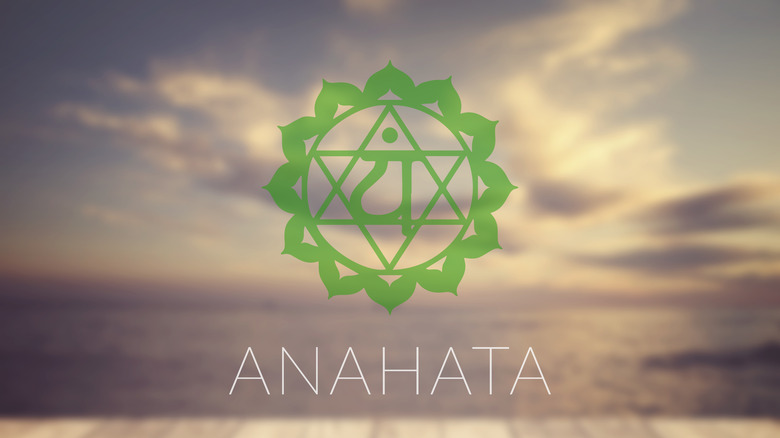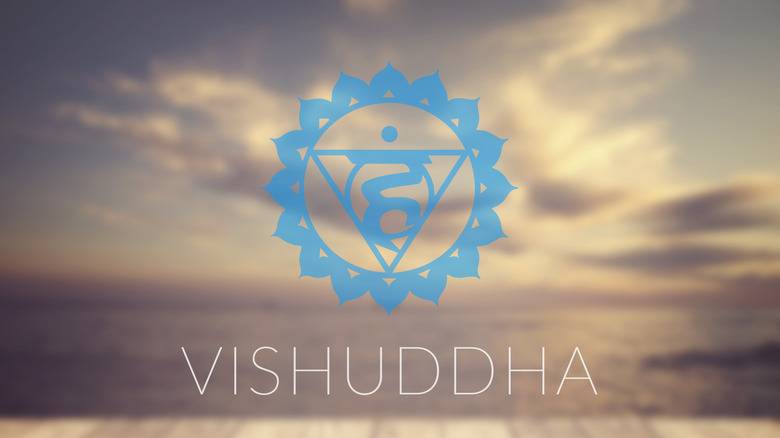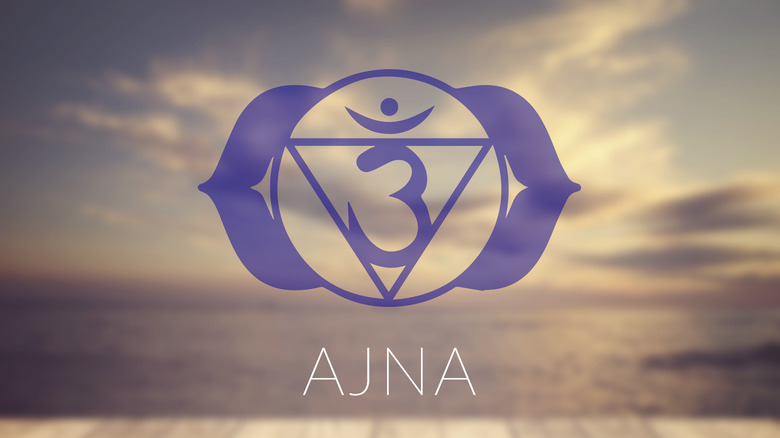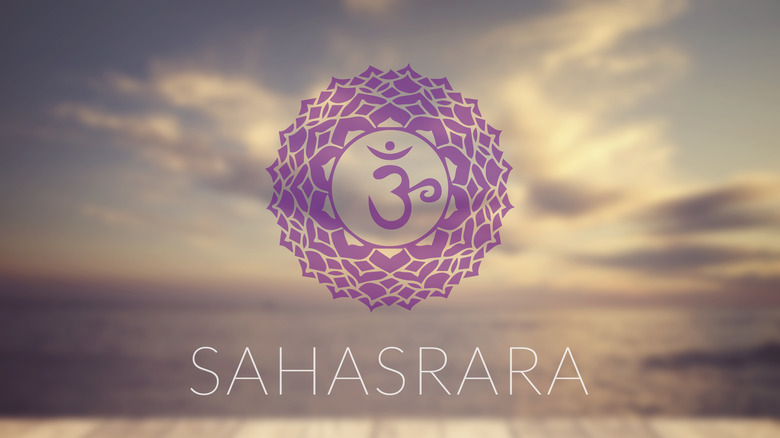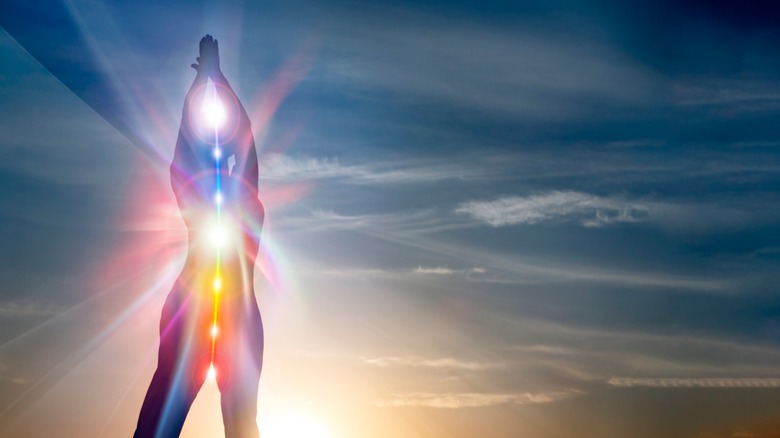The Meaning Behind The 7 Chakras In Hinduism
If you have ever stepped inside a New Age wellness center, explored guided meditation on YouTube, or read about the supposed healing properties of crystals, it's likely you have come across the term "chakras" and deduced that they are supposedly found in the human body. Possibly, you have also encountered the belief that chakras can become "blocked." But what does any of that mean?
Across a range of spiritual practices and belief systems, chakras are typically characterized as points throughout the body that act as centers of psychic energy and spiritual power, which may be activated to unlock human potential and counter spiritual and physiological problems. Due to their prominence in New Age mysticism and holistic medicine, to many Western ears chakras might sound like hoodoo. However, the concept of chakras goes back thousands of years to ancient India, and it remains a cornerstone of Hinduism even today.
Chakras are also found in other religions, most notably esoteric and Tibetan Buddhism, but only in Hinduism are they held as a central spiritual tenet across the religion as a whole. Here is how chakras are thought of in Hinduism, and the meaning of each of the main seven chakras they believe are found throughout the human body.
Chakras in Hinduism
"Chakra" is the Sanskrit word for "wheel," with such energy centers considered circular in Hindu belief and often represented as an open lotus flower. Chakras are most commonly associated with the Hindu god Vishnu, who is often portrayed holding a wheel. In Hinduism, both time and the universe itself are described in terms of a wheel, suggesting the cosmic nature of the energy that chakras are said to connect with.
There are seven main chakras according to Hinduism, starting from the very base of the torso and rising up along the spinal column to the very top of the head. Hinduism posits that there are in fact many hundreds of chakras found throughout the body, which all regulate psychic and spiritual energy and power. However, the central seven, which shall be outlined here, are the most important for physical and spiritual health and development and are what Hindus typically refer to when talking about the chakras of the human body.
It is important here to note that chakras are not considered to be psychical features, but rather are aspects of what is called the "subtle body," a spiritual extension of the consciousness that coexists with the physical or "gross" body. Chakras can be considered points at which the psychical and spiritual planes of existence intersect, and thus by interacting with certain chakras through certain practices — most commonly yoga and meditation in Hinduism — a person may learn to balance or align their seven chakras to achieve spiritual advancement and, eventually, a state of enlightenment.
Muladhara (Root Chakra)
The first chakra, Muladhara, is located at the base of the spine, specifically at the perineum. Because of this, it is also commonly known as the root chakra — the whole series of chakras is often described in terms of the growth of a flower or tree — but there are other reasons why this name is especially apposite.
The Muladhara — the name of which is a combination of the Sanskrit words meaning "source" and "support" — is considered fundamental to Hindu spiritual advancement and the unlocking of human potential. Represented as a four-petalled lotus and by the element earth, activation of the Muladhara is considered essential to enjoying personal security and stability, and therefore strength in the social and spiritual aspects of one's life.
The root chakra is also said to be the source of untapped energy and potential. Activating the chakra through meditation and other practices is said to allow one to channel energy up the spine toward the higher chakras and to expand one's consciousness into other spiritual fields. The spiritual energy in question is called kundalini, and for many practicing Hindus, harnessing one's kundalini is considered the key to achieving a higher plane of being. According to Anodea Judith's "Eastern Body, Western Mind," unbalanced chakras may be described as being "deficient" or "excessive," which in the case of the root chakra is said to lead to certain maladies. For example, a deficiency of the Muladhara is thought to lead to a disassociation with one's body, while an excess may cause one to practice greed or hoarding behavior. In meditation, the root chakra is activated by the syllable "lam" being repeated as a mantra.
Svadhisthana (Sacral Chakra)
The second chakra running up the spinal column of the human body is called Svadhisthana, the sacral chakra, which is depicted as being located just above the genitals in the same position as the bladder.
Represented as a six-petalled white lotus containing a crescent moon, the sacral chakra is symbolized by water, reflecting its position close to the bladder and urinary tract. Svadhisthana is the chakra that is most closely related to fluidity in all spheres of life, from social interactions to how flexible one wishes to be about one's identity and practices and one's boundaries in life. It is said to be activated by meditating on the mantra "vam."
But the sacral chakra is also, unsurprisingly, related to sexuality and pleasure, and is the chakra Hindus meditate over and try to balance to avoid issues such as a lack of libido or, on the contrary, sex addiction. Swadhisthana is closely associated with the moon — in Hinduism, the moon god is said to be responsible for fertility on Earth — and a crescent moon is featured in its symbol. It is also believed to be related to being creatively fertile and achieving what is often called a "flow" state.
Manipura (Solar Plexus Chakra)
The third chakra going upward from the base of the spine is located at the solar plexus, in the hollow between both sets of ribs, and is called Manipura, or, in English, the solar plexus chakra, though it is also noted in many sources as being aligned with the navel, the point at which humans are connected to the mother. Almost like a guiding light that draws the body forward, the Manipura is the seat of a person's self-confidence and self-esteem.
It is through this chakra that Hindu yogis focus on ego issues, but also those of personal drive and motivation. Judith explains that the solar plexus chakra provides agency when balanced, whereas a deficiency may cause a lack of self-control and lead to a reliance on compulsive habits. On the other hand, an excess of Manipura can lead to controlling behavior. The element of this chakra is fire, and it is useful to perhaps consider Manipura the spiritual center of one's "inner fire." In classical Hindu teaching this makes sense, as traditionally it is through "fire" that it was believed the digestive system breaks down food for nutrients. Manipura is a red ten-petalled lotus, meditated upon using the mantra "ram."
Anahata (Heart Chakra)
Above Manipura is found Anahata, the heart chakra, located in the middle of the chest. Hinduism typically associates the heart chakra with romantic love and personal relationships. Unlike the sexual associations of the sacral chakra, Anahata represents cosmic union between the sexes, with a six-pointed star over a 12-petalled grey lotus, though some sources describe Anahata as green. Though the star is perhaps reminiscent of the Star of David, experts claim that the two triangles, superimposed onto each other, symbolize cosmic union.
Anahata comes from the Sanskrit for "unbeaten drum," suggesting communication distinct from that of the physical senses. Its element is air, through which the cosmic vibrations of the universe may be carried. It is believed that a deficiency in the heart chakra may cause anti- and asocial tendencies, while an excess would lead to possessiveness, jealousy, and the overstepping of other people's boundaries. It is also the seat of empathy for people in general, and of self-love and compassion. It is activated by the syllable "yam" when used as a meditation mantra, according to Hindu yogis. In balancing the heart chakra, yogis often focus on breathing exercises that expand and contract the chest.
Vishuddha (Throat Chakra)
Vishuddha is the throat chakra, and somewhat unsurprisingly it is the chakra associated with speech and communication.
Traditionally, those considered to have a balanced Vishuddha are considered both clear communicators and receptive listeners, and are said to be identifiable by their bold, resonant voices. A deficiency of the throat chakra is said to manifest as shyness, both in terms of how loudly one is willing to speak and how often, while an excess is believed to cause the habit of talking too loudly and too often. Vishuddha is also linked to creativity, with meditation over the chakra said to aid in "finding your voice" in various art forms. Sound is particularly important in Hinduism, with the universe said to have been created by the god Shiva with the striking of a drum. Hence, sound is often evoked in Hinduism as being akin to cosmic energy, creation, and personal creativity. Vishuddha is also evoked with regard to musical ability, with tone-deafness and a lack of natural rhythm said to emanate from an imbalance in the chakra.
Activated through meditation using the syllable "ham," the throat chakra is represented as a brilliant or "golden" white lotus of 16 petals, according to Jean Varenne's "Yoga and the Hindu Tradition." The word "Vishuddha" translates as "filter," linking the chakra to purification and the purity of truth in communication.
Ajna (Third Eye Chakra)
Perhaps the most famous of the chakras, Ajna is located between the eyebrows and is known as the third eye chakra. Ajna is the Sanskrit word for "authority," or "a command," and the chakra is represented by a two-petalled white lotus. Its mantra during meditation is also the most famous of those used to activate the chakras: "om." It is the third eye chakra that is referenced by the wearing of a bindi between the eyebrows in some Hindu traditions. Om is the syllable that most vividly evokes oneness of the universe, and to meditate on Ajna through it is to come to terms with one's cosmic unity with everyone around us.
The third eye is the chakra most closely associated with sight, with bindis representing a third eye being "open" to the spiritual and physical worlds. When unbalanced, it is said that the closed third eye can lead to both delusions and a lack of empathy, i.e. the inability to perceive suffering in others or to see their point of view. The element of the third eye chakra is "light," suggesting both perception and clarity.
In some schools of yoga, it is the third eye chakra that is first activated through meditation, before practitioners focus on the others. It is thought that this increases clarity in the practice, and minimizes false perceptions that might hinder a yogi's path to higher consciousness.
Sahasrara (Crown Chakra)
The final, seventh chakra in the series is said to be located at the top of or just above the head, and is known in Sanskrit as Sahasrara, which means "thousand-petalled lotus." In English, it is often referred to as the crown chakra, and unlike the chakras below it that run up the spinal column to the eyebrow, it is assigned no other symbolic properties, such as color or element. Instead, Sahasrara is said to be related to "brahman," the ungraspable and mysterious essence of the universe as described in the Vedas, ancient scriptures that serve as the foundation of Hinduism.
Indeed, Sahasrara is considered somewhat different from the other chakras, and it doesn't have a specific mantra like those chakras discussed above. The crown chakra also differs in how it is depicted in that it appears to face down upon the body from above, whereas the lower chakras face outward. In this way, Sahasrara is shown as the portal to transcendence, a level above even the enlightenment achieved through the activation of the third eye chakra. As the chakra that is said to exist above the physical body, Sahasrara is considered to be apart from the physical world, and the chakra most closely associated with the divine.
As the chakra of thought and transcendence, Sahasrara when deficient is said to explain an obsession with material concerns over spiritual matters, while in excess it may cause an unhealthy addiction to spirituality.
The Kundalini
There is another aspect to be taken into account in relation to the chakras as commonly outlined in Hindu belief: that there is a sacred energy running through the human body — both physical and "subtle" — that links all of the chakras together and provides their activation. This energy is known in Sanskrit as kundalini, and it is considered an important concept in many yogic practices.
"Kundalini" translates to English as "she who is curled around upon herself," and is recognizable as the image of the ouroboros: the snake eating its own tail, which is a symbol of infinity. The energy that is said to exist in kundalini is also considered infinite in nature. Kundalini is described as a coiled serpent that resides in the root chakra, or Muladhara. It is believed that through yogic practices, the kundalini, like a snake, can be awoken to rise up through the chakras, empowering them in turn. In tantra, this is achieved by meditation on sexual energy, which is retained and instead channeled upward toward spiritual growth and endeavor.
The kundalini is commonly said to travel up through the subtle body in three channels, or nadis. The points at which these channels meet are the places in the body that correspond to the main chakras. The channels are said to be as fine as the stalks of a lotus flower.
Is there physical evidence for chakras?
There is no scientifically accepted evidence to support the existence of chakras, but then many Hindus would argue that is beside the point: As expressions of the "subtle body," chakras are distinct from the physical body, and just as the spiritual plane of existence could not be captured using a camera, the chakras of the body may not be definitively located in the way an organ might be. However, some sources do highlight the physiognomic features of the human body that seem to correspond with the chakras, such as the fact that the Muladhara's four-petalled lotus is uncannily reminiscent of the inferior hypogastric plexus, a nerve network found where the root chakra is said to reside. Similarly, others point to the existence of channels that run up the physical human spine as potential pathways for the flow of kundalini.
It is arguable, though, that the physical features of the body may have influenced the symbology of the chakras in the first place, and that it is, therefore, no surprise that their individual lotuses share commonalities with the body, or that the spine is believed to conduct spiritual energy in the same way we now know it carries signals through the nervous system. While chakras are certainly a reality for many Hindus and followers of certain other belief systems, the adoption of the chakra system in some forms of New Age spirituality has seen it stripped of its religious meaning, with some Western practitioners deploying the chakras on purely metaphorical grounds — for example, as an aid to psychotherapy.
